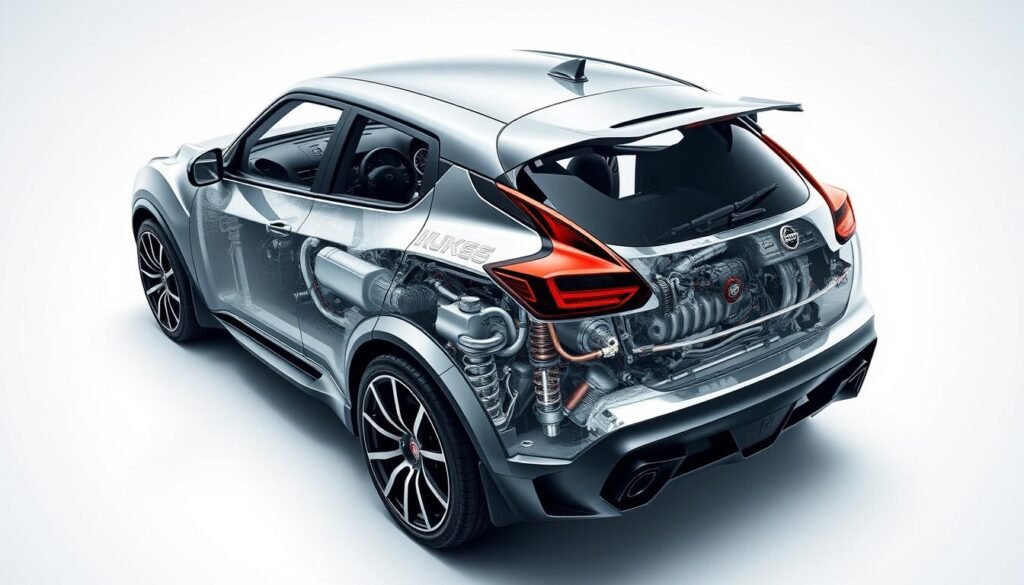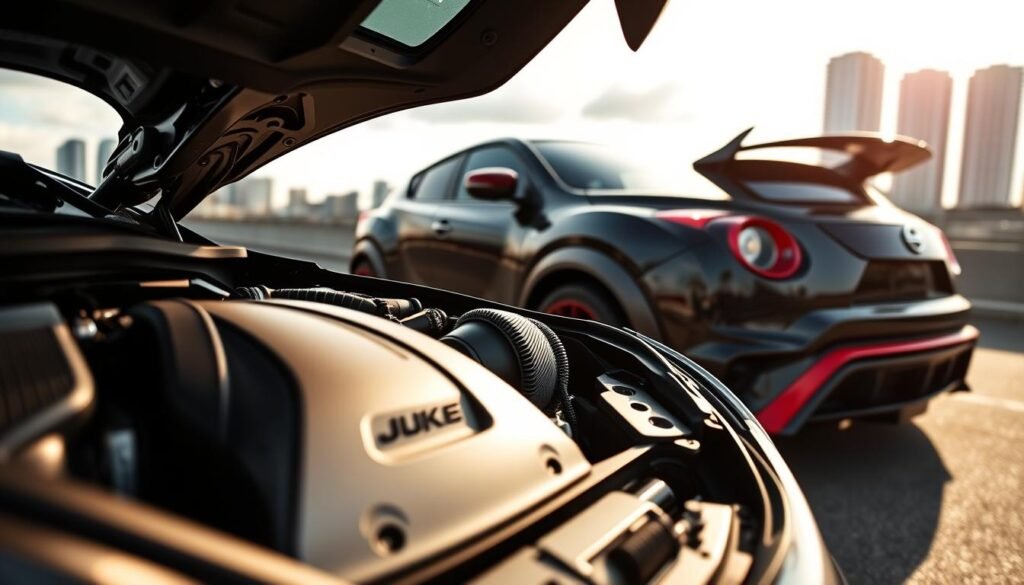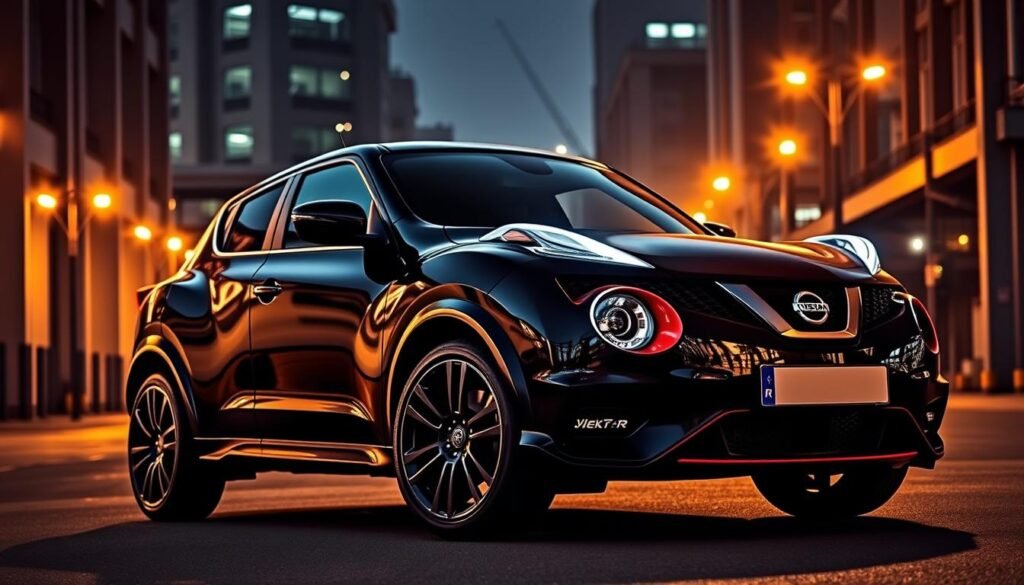Only a few dozen Nissan Juke R’s exist, but they can go as fast as a supercar. They look like a compact crossover but have a powerful Nissan GT-R heart. This mix makes them a rare halo car that amazed people everywhere.
This part introduces a detailed product review of the crossover supercar concept. The Nissan Juke R started as a daring idea and became a global sensation. Its early versions had a 3.8-liter V6 engine and all-wheel drive, showing it’s possible to have both speed and size.
With help from Nissan Europe and RML, the prototypes were made in just 22 weeks. They became famous, were used as pace cars, and showed how a small car can have big power. We’ll explore how it came to be, its significance, and what to look for if you’re interested in the Nissan Juke R.
The Nissan Juke R is more than just a car; it’s a symbol of rebellion. It combines the GT-R’s power with everyday practicality. Its rarity, bold design, and performance make it a standout in the United States and worldwide.
Overview and Origin Story of the Juke-R Concept
The Nissan Juke R started with a bold idea at Nissan Europe. They wanted to make a quirky crossover stand out. They aimed to mix GT-R power with Juke’s charm, keeping it practical for daily use.
From bar-napkin idea to halo car: why Nissan greenlit the wildest crossover
Nissan Europe’s team saw the GT-R as the spark to elevate the Juke. They turned a “what if” into a plan to create a memorable halo car. They aimed to blend showmanship with a functional cabin and clear specs.
They did CAD checks and tested mules to prove it could work. The Juke’s platform could handle the GT-R’s power, and it would look like a Juke. This led to turning the idea into a real car.
RML’s 22-week build timeline and collaboration with Nissan Europe
Nissan Europe teamed up with RML, a British motorsport firm. They worked together to design, build, and test the car in just 22 weeks.
Two prototypes were made under tight scrutiny. RML handled the technical tasks, while Nissan ensured the car stayed true to its brand. This fast work made the Nissan Juke R a serious project, not just a stunt.
How a GT-R chassis and drivetrain met a compact crossover body
The team started by cutting and fitting parts together. They combined the GT-R’s V6 engine, all-wheel drive, and electronics with the Juke’s body. They made changes to fit the powertrain and meet the specs.
They tested early versions to fine-tune the suspension and steering. The interior kept its Juke feel, with structural changes hinting at its racing intent. RML and Nissan Europe showed how to bring a wild idea to life with motorsport know-how and factory vision.
| Project Pillar | Lead Stakeholder | Key Actions | Outcome |
|---|---|---|---|
| Vision and Branding | Nissan Europe | Define halo concept, preserve Juke identity, set nissan juke r specs | Greenlight from idea to concept to reality |
| Engineering Delivery | RML | 22-week plan, CAD validation, prototype fabrication | Two running prototypes completed on schedule |
| Powertrain Integration | Joint RML/Nissan teams | Install GT-R V6, transaxle AWD, cooling and chassis reinforcements | Reliable integration inside compact crossover body |
| Usability and Identity | Nissan Technical Centre Europe | Retain core Juke cues, manage interior packaging | Recognizable Juke silhouette with motorsport flavor |
Nissan Juke R
The Nissan Juke R was made to stand out and change how people see the brand. It mixed the excitement of a supercar with the size of a compact crossover. This made everyone want to see it and hear its powerful engine.

Positioning as a brand halo and motorsport-inspired showcase
Nissan saw the Juke R as a statement on wheels. It took racing ideas and showed them off on city streets. This caught people’s attention and made them look at the rest of Nissan’s cars in a new light.
The car was a tech showcase, blending fun with power. Its engine and design proved Nissan could offer both. It was a car that showed what Nissan could do.
Key headlines: 3.8-liter twin-turbo V6, AWD, six-speed transaxle
Underneath, it had a 3.8-liter twin-turbo V6 and advanced AWD. It had a six-speed rear unit for quick shifts and strong starts. The early estimates for its horsepower were around 480, but later updates made it even more powerful.
It had RAYS forged wheels, GT-R brakes, and tuned suspension. This made it handle well and feel sharp. Every review talked about how it combined a crossover body with supercar performance.
Promo legacy: Dubai 24h pace car and viral supercar showdowns
The car quickly became famous thanks to its bold appearances. It was the pace car at the Dubai 24h, showing off its looks and sound. Then, a viral video in Dubai showed it racing supercars, making it even more popular.
This buzz led Nissan and RML to start making more Juke Rs. As they got more powerful engines, the car’s legend grew. Every review talked about how its AWD, engine, and media appearances kept it in the spotlight.
Engineering Deep Dive: Chassis, Drivetrain, and Packaging
The nissan juke r specs show the power of problem-solving. This unique car combined GT-R chassis, tight design, and careful work. RML engineering made every detail count for power, cooling, and control.
Solving wheelbase, width, and track challenges versus GT-R
The Juke body is shorter and narrower than a Nissan GT-R. To fix this, the team widened it by about five inches. They also made the track wider, by 2.5 inches at the front and nearly 3.5 inches at the rear.
This wider stance improved stability and handling. It also allowed for GT-R parts under the hood, keeping the car balanced at high speeds.
Transverse-to-longitudinal conversion and AWD integration
The car switched from a transverse four-cylinder to a longitudinal twin-turbo V6. The rear-mounted six-speed transaxle kept the GT-R’s power flow. This ensured quick AWD power shifts.
The engine bay was stretched to fit the V6. This move prioritized the GT-R’s layout and heat management over service access.
Structural changes, roll cage, and suspension/brake upgrades
A roll cage was added for better stability and rigidity. The suspension and brakes were also upgraded from GT-R parts. RML engineering made these changes to fit the car’s new dimensions.
Subframes and mounts were modified for better handling. This work allowed the body to handle high speeds without flexing. The result is a car with top-notch performance and handling.
| Area | Original Juke Constraint | Integration Solution | Benefit to Dynamics |
|---|---|---|---|
| Wheelbase & Width | Short wheelbase, narrow body | +5 in body width, front/rear track growth | Stability, better tire contact, calmer yaw |
| Powertrain Layout | Transverse 4-cyl packaging | Longitudinal V6 with six-speed transaxle | Authentic torque path, balanced weight split |
| AWD System | Not designed for high torque vectoring | Preserved GT-R AWD engineering | Traction under load, rapid torque transfer |
| Chassis Rigidity | Compact-crossover torsional limits | Integrated roll cage and reinforced nodes | Precise steering, consistent brake feel |
| Unsprung Hardware | OEM Juke suspension and brakes | GT-R-derived arms, uprights, and calipers | Heat capacity, geometry control, fade resistance |
Performance Highlights: nissan juke r engine, nissan juke r hp, nissan juke r 0-60
The Juke-R is a mix of supercar power and crossover style. It has a 3.8-liter V6 engine and a twin turbo setup. This makes it fast from the start.

Power figures from early 480–485 hp to later 545–600 hp builds
Early versions had about 480–485 hp. Later, they reached up to 545 hp. The 2.0 version even hit 600 hp, keeping the car responsive.
The twin turbo setup and intercooling fit in the car’s compact design. This allowed it to reach high speeds without losing control in tight spaces.
Real-world acceleration and published 0-62 mph claims
Factory claims said it could go from 0 to 62 mph in 3.7 seconds. Independent tests showed similar results. This shows the car’s quick start.
It also performed well in roll starts, thanks to its turbos. This was true on good tires and warm surfaces.
nissan juke r top speed and aerodynamic trade-offs
Despite its power, the top speed was around 160 mph. The car’s design increases drag, so it’s slower than the GT-R. At high speeds, it needs careful cooling and stability tuning.
Engineers worked to balance the engine’s power with gearing and damping. This made it fast and stable, but not too extreme.
| Version | Engine | Output (hp) | nissan juke r 0-60 | 0–62 mph (claimed) | nissan juke r top speed | Key Notes |
|---|---|---|---|---|---|---|
| Juke-R Prototype | 3.8-liter V6 nissan juke r twin turbo | 480–485 | ~3.5–3.6 sec | ~3.7 sec | ~160 mph | High drag limits v-max; fierce launches with AWD |
| Customer Juke-R | 3.8-liter V6 nissan juke r twin turbo | ~545 | ~3.4–3.5 sec | ~3.6–3.7 sec | ~160–165 mph | Updated GT-R tune; stronger midrange performance stats |
| Juke-R 2.0 | 3.8-liter V6 nissan juke r twin turbo | ~600 | ~3.2–3.4 sec | ~3.3–3.5 sec | ~165 mph | Power aligns with GT-R NISMO era; aero is the limit |
Design and Interior: nissan juke r interior and functional aero
Every part of the nissan juke r is designed for speed. Its interior matches its sleek body, combining practicality with a racing feel. Nissan’s official Juke R announcement shows how each detail boosts performance while keeping the Juke’s essence.
Wide arches, carbon-fiber elements, and cooling-focused bumpers
The car’s wide arches fit 20-inch RAYS wheels and GT-R brakes. Its front and back are reshaped for better airflow. This design is all about function, not just looks.
Later models got carbon fiber to lose weight and improve handling. New front bumpers also help with cooling, showing that a car can look tough without being just for show.
Retaining the Juke identity with a motorsport cockpit
Inside, the car keeps its familiar look but feels serious. The center console, inspired by motorcycles, stands out among GT-R gauges and a 7-inch LCD. The interior keeps the Juke’s vibe but adds racing features.
The trim is focused on grip and easy-to-read controls. The design makes it simple to see the road ahead.
OMP seats, roll cage, and the challenge of the center console
OMP race seats and a full roll cage make the cabin strong. The 4WD setup was tight, but the center console was kept. This shows the engineers’ skill in fitting everything without losing comfort.
The result is a cockpit that feels close and precise. With 20-inch RAYS wheels and carbon fiber, the car’s story continues inside, too.
Juke-R 2.0 Evolution: nissan juke r 2.0 and nissan juke-r 3.8 turbo
The 2014 facelift brought a new look to the nissan juke r 2.0. It had more power and a sleeker design. The car kept its bold stance but added race-bred tech for better handling.
Facelift updates, weight reduction, and enhanced cooling
Engineers used carbon panels and light materials to cut weight. The front got a new bumper and vents for better airflow. This updated aero helps manage heat and improves stability.
These changes made a big difference. The Nissan Juke R 2.0 overview shows wider grip and better airflow. It also cools down faster, allowing for longer high-speed drives.
Estimated performance with 600 hp GT-R/NISMO powertrain
The car has a 3.8-liter twin-turbo engine, making about 600 hp. It has all-wheel drive and a quick dual-clutch for fast starts and strong mid-range power.
Despite its tall design, it faces drag at high speeds. The team worked on aero, cooling, and traction. This lets the nissan juke-r 3.8 turbo perform well in real races.
How Juke-R 2.0 differs visually and mechanically
The 2.0 looks different with new intakes and carbon parts. It has cleaner lines that show its purpose. Mechanically, it has a stronger engine, better ducting, and less weight for quicker response.
These changes make the nissan juke r 2.0 a serious street car. It combines GT-R NISMO power with updated aero. This makes it a more complete car while keeping its bold spirit.
Rarity, Market, and Availability: how many nissan juke r were made and nissan juke r price
This rare supercar crossover is a dream for collectors. It’s a mix of concept and customer car. The story of its production starts with a big publicity push and ends with a small number of custom builds.
Prototype pair vs. low-volume, build-to-order production
Nissan and RML made two prototypes for shows and events. One was for left-hand drive, the other for right-hand drive. After the buzz, they started making cars for customers, using GT-R parts for the road.
These cars were made one at a time, with special powertrains and custom parts. This kept the number of cars very small. Each car has its own story, thanks to its unique VIN.
Reported intentions for limited Juke-R 2.0 runs
For Juke-R 2.0, Nissan aimed to make only a few dozen cars. But, not many have been delivered. This makes the car even more rare.
Finding a Juke-R 2.0 is a big deal. Each car shows off its special features and what the owner wanted.
Pricing realities and finding a juke r nissan in the wild
The price of a Juke-R reflects its complexity. It includes the cost of a GT-R, labor, and special certification. This makes it very expensive.
Ads for Juke-Rs pop up but disappear fast. They often go through private brokers. The hunt for one is part of the fun, showing that rare cars can surprise us.
| Aspect | Details | Why It Matters |
|---|---|---|
| Initial Output | Two prototypes (LHD and RHD) | Frames the baseline for how many nissan juke r were made at launch |
| Customer Builds | Low-volume, build-to-order | Explains limited production and bespoke variation |
| Juke-R 2.0 Intent | Reported very limited run | Signals continued scarcity and heightened demand |
| nissan juke r price | Supercar-level, case-specific | Reflects engineering effort and GT-R component costs |
| Market Visibility | Infrequent public sightings | Reinforces the model’s status as a rare supercar crossover |
Ownership Context in the United States: nissan juke r usa and special builds
The Juke R story hit the U.S. mainly through videos and events, not dealerships. Built in Europe with RML, it was showcased at places like the Dubai 24 Hours. This made it a curiosity for American fans who watched from afar.
Any nissan juke r usa sightings are from private sources. Buyers face hurdles like federal safety and emissions rules, plus state-by-state registration rules. Most cars that show up here are for track use or need expensive compliance work.
The Juke R’s European origins and custom build limited its U.S. presence. Nissan’s U.S. newsroom focused on common models. So, owners often turn to GT-R service networks and independent experts for support.
For collectors, the journey is narrow but straightforward. They buy abroad, cover shipping and duties, and plan for GT-R parts in a small body. This approach keeps the dream alive for those who want something rare without giving up quality.
Key takeaways: research regulations early, document the car’s history, and find service partners familiar with GT-R parts in a Juke body.
- Path to entry: private import, compliance prep, and selective state registration.
- Support network: GT-R technicians, parts sourcing from Nissan performance channels, and RML knowledge.
- Risk factors: evolving regulations, insurance valuation, and long lead times for bespoke components.
Those who succeed plan carefully, set budgets, and seek expert advice. This way, the nissan juke r usa story becomes a rare achievement in the U.S. market.
Conclusion
The Nissan Juke R is a wild mix: a compact crossover with GT-R power. RML and Nissan Europe built it fast, keeping the Juke’s look. It has a six-speed transaxle, AWD, and a full roll cage.
Early versions made 480–485 hp, while the 2.0 version hit near 600 hp. It goes from 0 to 62 mph in about 3.7 seconds. It tops out at around 160 mph, focusing on grip and cooling over speed.
It’s an ultimate crossover, with wider tracks and a longitudinal layout. It has serious brakes and suspension. The cabin combines Juke and GT-R features, with race seats.
Only a few were made, and they’re rare to see. In the U.S., it’s a statement piece, not for everyday driving. It shows big brands can be bold.
People talk about a nissan juke type r or even a nissan juke r 700. But the real magic is in the few cars made. For a detailed review, check out this first-drive report.
In conclusion, the Juke R is a rare oddity. It’s a fearless mix of a crossover’s shape and a supercar’s soul.

